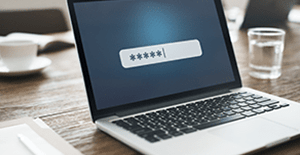How to Choose the Best Antivirus Software
Simplify your search for an antivirus software with this guide.
read morePublished on: May 1st, 2019

Two out of five people experience a security incident that could have been avoided with stronger cybersecurity efforts. With today’s technology, you need a password for every online account or device including social media accounts, emails, smartphones, and more. Keeping personal and business data safe begins with a secure password. Utilize these password best practices to avoid becoming a hacking or identity theft victim.
New security threats emerge every day, so it’s crucial to adapt and improve your cybersecurity measures in order to protect your data.

While this can seem like an insignificant step in securing your personal or business information, research shows that 73 percent of online accounts use duplicated passwords. Using the same password for multiple accounts is a security risk because once a hacker is able to identify one of your passwords, they can easily login to one or more of your other accounts that use the same password. Ensure your data is protected by assigning original passwords to each account.
If creating multiple passwords seems challenging, try using a password generator. Select how long the password should be, what symbols and numbers to include, and a strong password will populate. Apple users can take advantage of strong password suggestions when signing up for a new account or changing passwords on their device. Both password generators and Apple suggestions tend to create long passwords in an effort to best secure your data. Since passwords should be difficult to guess, the experts at Computer Troubleshooters recommend using password generators to help you create original login information.
Secure passwords include multiple characters and numbers and keeping track of several complex logins can be difficult. Using a password managing software eliminates the need to remember every high-strength password you create and which account it belongs to. Software programs such as LastPass streamline both personal and business account passwords. You simply need to remember one master password, and LastPass will keep track of the others so you can rest assured knowing your information is secure.
Along with using strong passwords, enabling two-factor authentication on all of your accounts ensures your data is safe from security threats. When you log in to an account using two-factor authentication, you are required to prove your identity in two steps. The most common way websites use this is by texting a code to your cell phone, which you then have to enter on the account you’re logging into along with your password. Using two-factor authentication provides an extra layer of security beyond a username and password.
When you’re targeted by a hacker, not only is your personal information at risk, but hackers can also install malware onto your device causing harm to your computer. Utilizing the above password best practices will improve your cybersecurity and your defense against hackers, but passwords are only one component of cybersecurity. Contact your nearest Computer Troubleshooters office to create a personalized plan to secure your data and keep your network safe.
Simplify your search for an antivirus software with this guide.
read moreHave you received this notorious Windows error screen? Here’s how to fix it.
read more© 2025 Computer Troubleshooters.